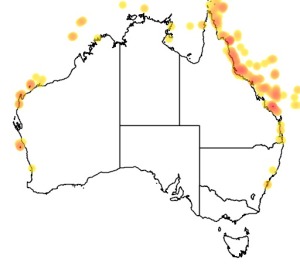
©Philip Dunbavan: Plectropomus leopardus with normal colouration at Big Vicki's Reef, Lizard Island.
Colours
Distinguishing features
A large slender rock cod with a pale to dark brown body covered with regularly spaced bright blue dots. The colouration can be quickly changed depending on the mood of the fish. Fish actively hunting assume a mottled colouration. Distinguish from the closely related Plectropomus maculatus by the small spots (not elongate bars) on the head region, and from Plectropomus laevis by the convex outer margin of the anal fin and the lack of dark saddles on the back. Plectropomus maculatus is found mainly on inshore reefs, and Plectropomus laevis mainly on offshore reefs, but both are occasionally seen on Lizard. During the daytime usually seen singly or in pairs, swimming slowly or resting on coral or the sea floor in ambush position near schools of damselfish.
Size
- Up to 120 cm (Standard length)
Depth range
- Depth range data is not yet available.
Synonyms
Similar taxa
Distribution
Distribution and habitat preferences
Areas of good coral cover on reef fronts, flats, and lagoonal and back reef patches, although this species will also move into shallow rubble areas to feed.
Can be found in most locations around the island.
Behaviour
The Common Coral Trout is a diurnally active ambush predator which feeds on small fishes, cephalopods and crustaceans as a juvenile, then almost exclusively reef fishes as an adult. The Coral Trout lie in wait near schools of plankton feeding fishes and make periodic rapid attacks from cover, especially near dawn and dusk. Coral Trout migrate to spawning sites on the new moon in October and November where they undertake mass spawning behaviour. All fish start life as females and change sex to male only when they reach a larger size. Maximum age is 26 years. This species is one of the main targets of the commercial line fishery on the Great Barrier Reef.
Web resources
References
- Adams, S. (2003). Morphological ontogeny of the gonad of three plectropomid species through sex differentiation and transition, Journal of Fish Biology, 63: 22-36. LIRS catalog number 90136.
- Barnett, L.J., T.L. Miller and T.H. Cribb (2010). Two new Stephanostomum-like cercariae (Digenea: Acanthocolpidae) from Nassarius dorsatus and N. olivaceus (Gastropoda: Nassariidae) in central Queensland, Australia, Zootaxa, 2445: 35-52. LIRS catalog number 1332.
- Bott, N.J., T.L. Miller and T.H. Cribb (2013). Bucephalidae (Platyhelminthes: Digenea) of Plectropomus (Serranidae: Epinephelinae) in the tropical Pacific. Parasitology Research, 112: 2561-2584. LIRS catalog number 1717.
- View all references








